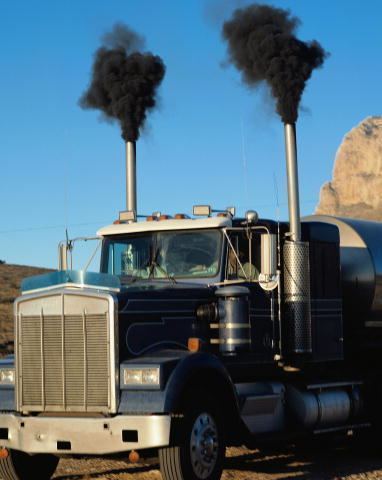 | ||
Soot /ˈsʊt/ is a mass of impure carbon particles resulting from the incomplete combustion of hydrocarbons. It is more properly restricted to the product of the gas-phase combustion process but is commonly extended to include the residual pyrolysed fuel particles such as coal, cenospheres, charred wood, and petroleum coke that may become airborne during pyrolysis and that are more properly identified as cokes or chars.
Contents
Soot causes cancer and lung disease, and is the second-biggest human cause of global warming.
Description
The formation of soot is a complex process, an evolution of matter in which a number of molecules undergo many chemical and physical reactions within a few milliseconds. Soot is a powder-like form of amorphous carbon. Gas-phase soot contains polycyclic aromatic hydrocarbons (PAHs). The PAHs in soot are known mutagens and are classified as a "known human carcinogen" by the International Agency for Research on Cancer (IARC). Soot forms during incomplete combustion from precursor molecules such as acetylene. It consists of agglomerated nanoparticles with diameters between 6 and 30 ㎚. The soot particles can be mixed with metal oxides and with minerals and can be coated with sulfuric acid.
Soot formation mechanism
Many details of soot formation chemistry remain unanswered and controversial, but there have been a few agreements:
Hazards
Soot, particularly diesel exhaust pollution, accounts for over one quarter of the total hazardous pollution in the air.
Among these diesel emission components, particulate matter has been a serious concern for human health due to its direct and broad impact on the respiratory organs. In earlier times, health professionals associated PM10 (diameter < 10 μm) with chronic lung disease, lung cancer, influenza, asthma, and increased mortality rate. However, recent scientific studies suggest that these correlations be more closely linked with fine particles (PM2.5) and ultra-fine particles (PM0.1).
Long-term exposure to urban air pollution containing soot increases the risk of coronary artery disease.
Diesel exhaust (DE) gas is a major contributor to combustion-derived particulate-matter air pollution. In human experimental studies using an exposure chamber setup, DE has been linked to acute vascular dysfunction and increased thrombus formation. This serves as a plausible mechanistic link between the previously described association between particulate matter air pollution and increased cardiovascular morbidity and mortality.
Soot also tends to form in chimneys in domestic houses possessing one or more fireplaces. If a large deposit collects in one, it can ignite and create a chimney fire. Regular cleaning by a chimney sweep should eliminate the problem.
Soot modeling
Soot mechanism is difficult to model mathematically because of the large number of primary components of diesel fuel, complex combustion mechanisms, and the heterogeneous interactions during soot formation. Soot models are broadly categorized into three subgroups: empirical (equations that are adjusted to match experimental soot profiles), semi-empirical (combined mathematical equations and some empirical models which used for particle number density and soot volume and mass fraction), and detailed theoretical mechanisms (covers detailed chemical kinetics and physical models in all phases) are usually available in the literature for soot models.
Empirical models use correlations of experimental data to predict trends in soot production. Empirical models are easy to implement and provide excellent correlations for a given set of operating conditions. However, empirical models cannot be used to investigate the underlying mechanisms of soot production. So, these models are not flexible enough to handle changes in operating conditions. They are only useful for testing previously established designed experiments under specific conditions.
Second, semi-empirical models solve rate equations that are calibrated using experimental data. Semi-empirical models reduce computational costs primarily by simplifying the chemistry in soot formation and oxidation. Semi-empirical models reduce the size of chemical mechanisms and use simpler molecules, such as acetylene as precursors. Detailed theoretical models use extensive chemical mechanisms containing hundreds of chemical reactions in order to predict concentrations of soot. Detailed theoretical soot models contain all the components present in the soot formation with a high level of detailed chemical and physical processes.
Such comprehensive models (detailed models) usually take high financial burden for programming and operating, and much computational time to produce a converged solution. On the other hand, empirical and semi-empirical models ignore some of the details in order to make complex model simple and to reduce the computational cost and time. Thanks to recent technological progress in computation, it becomes more feasible to use detailed theoretical models and obtain more realistic results. However, further advancement of comprehensive theoretical models must be preceded by the more detailed and accurate formation mechanisms.
On the other hand, models that are based on a phenomenological description have found wide use recently. Phenomenological soot models, which may be categorized as semi-empirical models, correlate empirically observed phenomena in a way that is consistent with the fundamental theory, but is not directly derived from the theory. Phenomenological models use sub-models developed to describe the different processes (or phenomena) observed during the combustion process. These sub-models can be empirically developed from observation or by using basic physical and chemical relations. Advantages of phenomenological models are that they are quite reliable and yet not so complicated. So, they are useful, especially when the accuracy of the model parameters is low. For example, the phenomenological models can predict the soot formation even when several operating conditions are changed in a system and the accuracy cannot be guaranteed. Examples of sub-models of phonological empirical models could be listed as spray model, lift-off model, heat release model, ignition delay model, etc.
